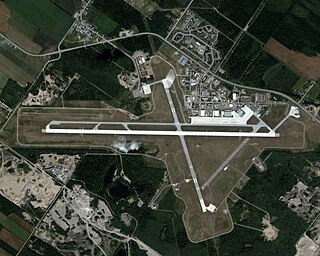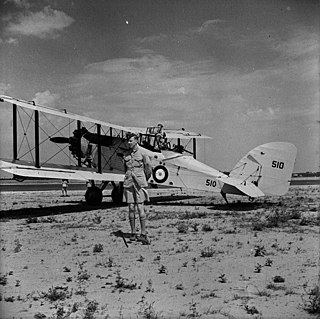
The Bell CH-146 Griffon is a multi-role utility helicopter designed by Bell Helicopter Textron as a variant of the Bell 412EP for the Canadian Armed Forces. The CH-146 is used in a wide variety of roles, including aerial firepower, reconnaissance, search and rescue and aero-mobility tasks.

The Westland Lysander is a British army co-operation and liaison aircraft produced by Westland Aircraft that was used immediately before and during the Second World War.

The Royal Canadian Air Force is the air and space force of Canada. Its role is to "provide the Canadian Forces with relevant, responsive and effective airpower". The RCAF is one of three environmental commands within the unified Canadian Armed Forces. As of 2020, the Royal Canadian Air Force consists of 12,074 Regular Force and 1,969 Primary Reserve personnel, supported by 1,518 civilians, and operates 258 manned aircraft and 9 unmanned aerial vehicles. Lieutenant-General Al Meinzinger is the current commander of the Royal Canadian Air Force and chief of the Air Force Staff.

Canadian Forces Base Goose Bay, commonly referred to as CFB Goose Bay, is a Canadian Forces Base located in the municipality of Happy Valley-Goose Bay in the province of Newfoundland and Labrador. It is operated as an air force base by the Royal Canadian Air Force (RCAF). Its primary RCAF lodger unit is 5 Wing, commonly referred to as 5 Wing Goose Bay.

Canadian Forces Base Greenwood, or CFB Greenwood, is a Canadian Forces Base located 1.5 nautical miles east of Greenwood, Nova Scotia. It is primarily operated as an air force base by the Royal Canadian Air Force and is one of two bases in the country using the CP-140 Aurora and CP-140A Arcturus anti-submarine/maritime patrol and surveillance aircraft. Its primary RCAF lodger unit is 14 Wing, commonly referred to as 14 Wing Greenwood.

438 "City of Montreal" Tactical Helicopter Squadron is a unit of the Royal Canadian Air Force. The squadron operates the CH-146 Griffon tactical helicopter from the Hartland de Montarville Molson Hangar of CFB St. Hubert in Quebec, Canada. Its tasks include armed and unarmed tactical utility transport, training aircrew personnel in basic and advanced aviation tactics, technical training of groundcrew personnel and flight engineers and the periodic maintenance of CH-146 fleet aircraft. They also include as residual capabilities search and rescue, reconnaissance and support to federal, provincial and local law enforcement agencies. A "total force" unit composed of members of the Regular Force, and both full time and part time reservists, the squadron is part of 1 Wing at CFB Kingston Ontario.

Canadian Forces Base Trenton, formerly RCAF Station Trenton, is a Canadian Forces base located within the city of Quinte West, Ontario. It is operated as an air force base by the Royal Canadian Air Force (RCAF) and is the hub for air transport operations in Canada and abroad. Its primary RCAF lodger unit is 8 Wing, commonly referred to as 8 Wing Trenton. CFB Trenton is Canada's largest Air Force base.

Canadian Forces Base Bagotville, commonly referred to as CFB Bagotville, and also known as Bagotville Airport or Saguenay-Bagotville Airport, is a Canadian Forces base located 4.5 nautical miles west of Bagotville in the city of Saguenay. Located in the centre of Quebec, less than 200 km (120 mi) north of Quebec City, CFB Bagotville is operated as an air force base by the Royal Canadian Air Force (RCAF) and is one of two bases in the country using the CF-18 Hornet fighter/interceptor, the other being CFB Cold Lake. Its primary RCAF lodger unit is 3 Wing, commonly referred to as 3 Wing Bagotville.

408 Tactical Helicopter Squadron is a unit of 1 Wing, Kingston. It is co-located with 1 Canadian Mechanized Brigade Group at Canadian Forces Base (CFB) Edmonton.
Canadian Forces Base Toronto is a former Canadian Forces base in Toronto, Ontario. The airfield is currently operated as Toronto / Downsview Airport.

402 "City of Winnipeg" Squadron is a Royal Canadian Air Force squadron based in Winnipeg, Manitoba, Canada

No. 414 Squadron RCAF is a Royal Canadian Air Force squadron. It is currently located in Ottawa and conducts electronic warfare support training for other units in the Canadian Armed Forces.

403 "City of Calgary" (Helicopter) Operational Training Squadron is a squadron of the Royal Canadian Air Force (RCAF) located at Canadian Forces Base Gagetown. It is equipped with CH-146 Griffons and provides operational aircrew training to the crews who will fly the helicopter. The squadron also conducts operational test and evaluation, develops aviation tactics and carries out operations in support of the 1 Wing mission. It also supports the local Army requirements of the Combat Training Centre. It was founded as No. 403 Squadron RCAF.

427 Special Operations Aviation Squadron is a tactical helicopter unit that provides aviation support to Canadian Special Operations Forces Command. The squadron is based at CFB Petawawa, Ontario with a fleet of Bell CH-146 Griffon helicopters. It was founded during the Second World War as No. 427 Squadron RCAF.

424 Transport and Rescue Squadron, nicknamed "Tiger Squadron", is a Royal Canadian Air Force strategic transport and search and rescue unit based at Canadian Forces Base (CFB) Trenton in the Canadian province of Ontario. The squadron is the primary provider of search and rescue response for the Trenton Search and Rescue Region, which extends from Quebec City to the Rocky Mountains, and from the Canada–United States border to the North Pole, covering an area of over ten million square kilometres in Central, Western, and Northern Canada.

430 Tactical Helicopter Squadron is a unit of the Canadian Forces under the Royal Canadian Air Force. It operates Bell CH-146 Griffons from CFB Valcartier, near Quebec City in Quebec, Canada.

439 Combat Support Squadron is a squadron of the Royal Canadian Air Force, based in Bagotville, Quebec.
No. 2 Squadron was a Royal Canadian Air Force (RCAF) squadron active during the late 1930s. The squadron operated army cooperation aircraft from 1935, and upon the outbreak of World War II was selected for overseas duty. However, a shortage of aircraft forced its disbandment in late 1939 to reinforce two other squadrons.

No. 3 (Bomber) Squadron was a Royal Canadian Air Force (RCAF) squadron active during the late 1930s.
This is the structure of the Royal Canadian Air Force, as of November 2020.



















